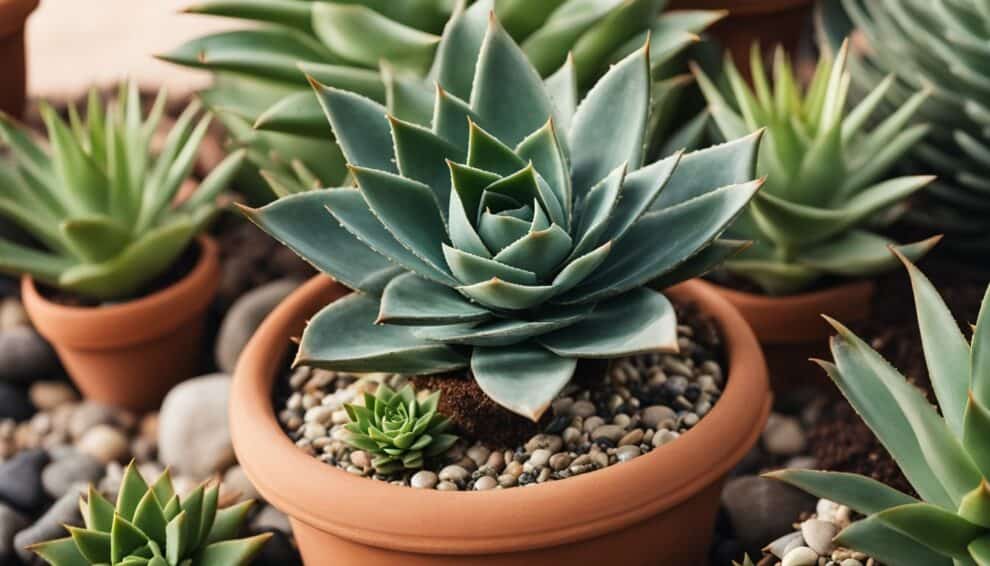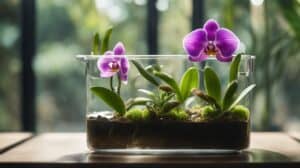Spiral Aloe, or Aloe Polyphylla, is a unique and visually stunning succulent that is native to the mountains of Lesotho in South Africa.
Its distinctive spiral shape and vibrant green leaves make it a popular choice for gardeners and plant enthusiasts alike.
However, Spiral Aloe is notoriously difficult to propagate, which can make it challenging for those looking to grow their own plants.

Fortunately, with the right knowledge and techniques, it is possible to successfully propagate Spiral Aloe.
This guide will provide a step-by-step process for propagating Aloe Polyphylla, including tips for selecting the right soil, preparing the plant for propagation, and caring for the new plant once it has been successfully propagated.
Whether you are a seasoned gardener or just starting out, this guide will provide valuable information for anyone looking to grow their own Spiral Aloe plant.
Understanding Aloe Polyphylla

Species Overview
Aloe Polyphylla, commonly known as the Spiral Aloe, is a unique and fascinating succulent that is native to the Maluti Mountains of Lesotho in Southern Africa.
This plant is known for its distinctive spiral-shaped rosette of leaves that grow in a clockwise or counterclockwise direction, making it a popular choice among plant enthusiasts and collectors.
The Spiral Aloe is a slow-growing plant that can reach up to 1-2 feet in height and 2-3 feet in width.
It is a relatively small plant compared to other aloe species, but its striking appearance and symmetrical shape make it a standout in any collection.
Growth Patterns
The Spiral Aloe is a monocarpic plant, meaning it flowers only once in its lifetime before dying.
However, it can take up to 10-15 years for the plant to reach maturity and flower.
The flowers of the Spiral Aloe are a beautiful shade of pink and attract a variety of pollinators.
In terms of care, the Spiral Aloe prefers well-draining soil and requires moderate watering.
It is best to avoid overwatering the plant, as it can lead to root rot and other issues.
Overall, the Spiral Aloe is a unique and stunning plant that is sure to impress any plant enthusiast.
With proper care and attention, it can thrive in a variety of environments and make a beautiful addition to any collection.
Propagation Basics
Methods of Propagation
Spiral aloe propagation can be done by seeds or offsets.
Seeds are the most common method of propagation, but it can take up to five years for the plant to mature.
Offsets, on the other hand, are clones of the parent plant and can be propagated much faster.
To propagate by seeds, it is important to use fresh seeds and plant them in a well-draining soil mix.
Cover the seeds lightly with soil and keep them moist until they germinate.
Once the seedlings have grown large enough, they can be transplanted into individual pots.
To propagate by offsets, wait until the parent plant produces small plantlets at its base.
Carefully remove the offsets from the parent plant and plant them in their own pots.
Ensure that the soil is well-draining and that the offsets receive enough sunlight and water.
Best Time for Propagation
The best time to propagate spiral aloe is during the spring or summer months when the plant is actively growing.
This will give the plant the best chance to establish itself and grow strong roots.
Avoid propagating during the winter months when the plant is dormant, as this can cause stress and potentially harm the plant.
Additionally, avoid propagating during periods of extreme heat or cold as this can also cause stress and damage to the plant.
Overall, propagating spiral aloe can be a rewarding experience for gardeners and plant enthusiasts.
By following these basic guidelines and using proper care and attention, one can successfully propagate and grow this stunning plant.
Step-by-Step Propagation

Seed Propagation
To propagate a Spiral Aloe by seed, one must first obtain the seeds. The seeds can be purchased from a reputable dealer or harvested from mature plants.
Once the seeds are obtained, they should be sown in well-draining soil. The soil should be kept moist, but not overly wet.
It is best to sow the seeds in the spring or early summer.
The seeds will typically germinate within 2-4 weeks, and the seedlings should be kept in a warm and bright location.
After the seedlings have grown their first set of true leaves, they can be transplanted into individual pots.
The seedlings should be kept in a bright location, but not in direct sunlight.
Pup Division
To propagate a Spiral Aloe by pup division, one must first identify the pups. The pups are small offsets that grow at the base of the parent plant.
Once the pups are identified, they can be carefully removed from the parent plant using a sharp, sterile knife.
The pups should be allowed to dry for a day or two before being transplanted into their own pots.
The soil should be well-draining, and the pups should be planted at the same depth as they were growing on the parent plant.
The newly transplanted pups should be kept in a bright location, but not in direct sunlight.
Propagation by pup division is the preferred method of propagation, as it ensures that the new plants will be genetically identical to the parent plant.
This method also allows for the new plants to mature more quickly than those propagated by seed.
Post-Propagation Care

Watering and Feeding
After propagating the spiral aloe, it is essential to give it the right amount of water and nutrients to ensure its healthy growth.
The plant should be watered once a week during the growing season, and the soil should be allowed to dry out between watering to prevent root rot.
During the winter months, watering should be reduced to once every two to three weeks.
When it comes to feeding, the spiral aloe requires a balanced fertilizer that is low in nitrogen.
Fertilizer should be applied every two to three months during the growing season to provide the plant with the necessary nutrients.
Sunlight and Temperature
The spiral aloe requires bright, indirect sunlight to thrive. It should be placed in a south-facing window or under grow lights for at least six hours a day.
During the summer months, the plant should be protected from direct sunlight, which can scorch the leaves.
The ideal temperature for the spiral aloe is between 60-80°F (15-27°C).
It is essential to keep the plant away from drafts and extreme temperature changes, which can cause stress and damage to the plant.
Common Issues and Solutions
The spiral aloe is a hardy plant, but it can still be susceptible to certain issues.
Overwatering can cause root rot, which can be prevented by allowing the soil to dry out between watering.
Pest infestations, such as mealybugs and spider mites, can be treated with insecticidal soap or neem oil.
If the leaves of the spiral aloe turn brown or black, it may be a sign of sunburn or overwatering.
In this case, the plant should be moved to a shadier location or allowed to dry out before watering again.
By following these post-propagation care tips, the spiral aloe can thrive and bring beauty to any indoor or outdoor garden.
Frequently Asked Questions

How do I propagate Spiral Aloe from seed?
Spiral Aloe propagation from seed is a time-consuming process that requires patience and care.
To start, you will need to collect fresh seeds from a mature and healthy Spiral Aloe plant.
Once you have the seeds, soak them in water for 24 hours to help soften the outer layer.
After soaking, plant the seeds in a well-draining soil mixture and keep them in a warm, humid environment.
It can take several weeks or even months for the seeds to germinate.
What are the ideal conditions for growing Spiral Aloe indoors?
Spiral Aloe can be grown indoors, but it requires bright, indirect sunlight and well-draining soil.
The ideal temperature range for growing Spiral Aloe indoors is between 60-80°F (15-27°C).
It’s important to avoid overwatering, as this can cause root rot.
Allow the soil to dry out between waterings, and be sure to provide adequate air circulation to prevent fungal growth.
How often should Spiral Aloe be watered?
Spiral Aloe is a succulent plant that is adapted to dry, arid conditions. As such, it does not require frequent watering.
In fact, overwatering can be detrimental to the health of the plant. It’s best to allow the soil to dry out completely between waterings.
Depending on the humidity and temperature of your environment, this may mean watering once every 2-3 weeks.
What type of soil mixture is best for Aloe Polyphylla?
Spiral Aloe requires a well-draining soil mixture that is rich in organic matter. A mixture of equal parts sand, perlite, and peat moss is a good option.
It’s important to avoid heavy, clay-like soils that can retain too much moisture and cause root rot.
At what stage does the Spiral Aloe start to flower?
Spiral Aloe typically begins to flower when it reaches maturity, which can take several years.
The plant will produce a tall, slender stalk with clusters of bright red or orange flowers at the top.
The flowers usually bloom in the late spring or early summer.
Can Spiral Aloe be grown in colder climates?
Spiral Aloe is native to Lesotho, a country in southern Africa with a mild, Mediterranean climate.
While it can tolerate some frost and cold temperatures, it is not well-suited for extremely cold climates.
If you live in a colder climate, it’s best to grow Spiral Aloe indoors or in a greenhouse where you can control the temperature and humidity.













